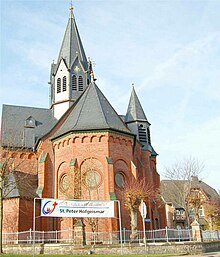Georg Kegel
Georg Karl Wilhelm Kegel (born September 22, 1857 in Cassel ; † December 26, 1912 there ) was a German architect of historicism .
Life
Georg Kegel was born in 1857 as the eighth of eleven children of the photographer and lithographer August Ernecke Georg Kegel senior (1821–1884), who opened a lithography workshop in Kassel in 1849 and founded the Photographic Institute for photographs on paper and daguerreotype portraits . His father was born in what was then the Ziehers domain one kilometer east of Fulda, where his grandfather was a tenant.
After attending the Lyceum Fridericianum, he studied from 1874 to 1878 at the Royal Technical University of Hanover with Conrad Wilhelm Hase and in 1876 became an active member of the Catholic student association AV Gothia in KV . In 1887, after having passed the second state examination, he was appointed government architect. From 1888 to 1893 he was a teacher at the building trade school in Kassel , but then retired from civil service and worked as a freelancer in Kassel until his death. Numerous study trips took him to Great Britain, France, Denmark, Italy and Austria.
A son of Georg Kegel was Sturm Kegel .
Act
As an architect, Georg Kegel designed 24 Catholic churches and chapels in the area of the Diocese of Fulda as well as numerous secular buildings. He preferred neo-Gothic and neo-Romanesque elements, but also forms from the Renaissance . Typical were his designs, which were strictly oriented towards the use, and the confident combination of traditional, local materials such as natural stone and half-timbering. Among his most important works are the two large Catholic parish churches St. Maria (called Rosary Church) and St. Familia in Kassel.
Kegel was a member of the Association of German Architects (BDA) founded in 1903 and was chairman of the BDA local group in Kassel for several years.
For more than 25 years he carried out preparatory work for the restoration of the St. Peter cathedral in Fritzlar . He died surprisingly when the work began.
buildings



(incomplete list)
Sacred buildings:
- 1886: Rimmels - Chapel of St. Anthony the Hermit
- 1888: Silges - St. Odilia branch church
- 1888: Gotthards - Filialkirche St. Anna
- 1890: Parents - cath. Parish Church of St. Vitus and Anna
- 1890–1891: Bad Sooden-Allendorf - St. Bonifatius (demolished in 1959)
- 1891–1892: Petersberg-Steinhaus - St. Nikolaus
- 1892–1893: Höchst an der Kinzig - St. Wendelin branch church with rectory (demolished in 1963)
- 1894–1901: Spahl - St. Cyriakus
- 1897: Hofgeismar - cath. Parish Church of St. Peter
- 1897–1899: Kassel, Kölnische Strasse - cath. Parish Church of St. Familia
- 1899–1901: Hofbieber - cath. Parish Church of St. George
- 1899–1901: Kassel, Kirchweg - cath. Parish Church of St. Maria (Rosary Church)
- 1899–1909: Eichenzell -Rothemann - St. Barbara (demolished in 1962)
- 1902: Fulda-Kämmerzell - St. Rochus pilgrimage chapel, vestibule
- 1903–1904: Biebergemünd - St. Johannes Nepomuk (expansion)
- 1904: Oberndorf - St. Martin (expansion)
- 1904–1905: Eschwege - St. Elisabeth
- 1905–1907: Eichenzell -Buchenberg - St. Jakobus
- 1912–1914: Hofbieber-Schwarzbach - St. Maria vom Berge Karmel (called "Rhön Cathedral")
- 1912–1914: Amöneburg-Mardorf - Kellmark Chapel (Mariæ Visitation)
Profane buildings:
- 1891–1892: Fulda - Villa Marx (demolished 1969)
- 1891–1894: Bad Sooden-Allendorf - Rothestein Castle
- 1897–1913: Kassel - cath. Lyceum "Engelsburg" (today's Engelsburg-Gymnasium ), intermediate building with dining room and chapel, new building Akazienweg, new building Rector's house
- 1898: Kassel-Wilhelmshöhe - terminal building of tram line 1 (today the visitor center of the Hessen Kassel Museum Landscape )
- 1900: Kassel-Wilhelmshöhe - tram depot (demolished)
- 1900–1907: Hannoversch Münden - Kurhessen barracks
- 1912–1913: Naumburg (Hessen) - elementary school (today used as town hall)
Web links
- Record on Georg Kegel in the database of architects and artists with direct reference to Conrad Wilhelm Hase (1818–1902) , accessed on August 4, 2014
Individual evidence
- ↑ Erwin Sturm : Builder of Historicism: Georg Kegel , Buchenblätter (supplement of the Fuldaer Zeitung ), No. 69th year 1996, No. 28 of October 8, 1996, pp. 109–111
- ^ Siegfried Koß, Wolfgang Löhr (Hrsg.): Biographisches Lexikon des KV. 7th part (= Revocatio historiae. Volume 9). Akadpress, Essen 2010, ISBN 978-3-939413-12-7 , p. 74.
- ^ Hessische Niedersächsische Allgemeine from December 24, 2012
- ↑ Documentation on the exhibition on the occasion of the 100th anniversary of death
- ↑ Michael Mott : From the early days. The beautiful Villa Marx. A gem in Lindenstrasse. Built in 1892, demolished in 1969. Praised as emblematic architecture of the imperial era. In: Fuldaer Zeitung of September 23, 1998, p. 14. (Series: Fulda once and now)
| personal data | |
|---|---|
| SURNAME | Kegel, Georg |
| ALTERNATIVE NAMES | Kegel, Georg Karl Wilhelm (full name) |
| BRIEF DESCRIPTION | German architect of historicism |
| DATE OF BIRTH | September 22, 1857 |
| PLACE OF BIRTH | kassel |
| DATE OF DEATH | December 26, 1912 |
| Place of death | Cassel |
